The product-portfolio of our barthhaas-hops is enormous. Especially the amount of hop varietys we offer. Often it is hard for customers to fully understand and imagine how one hop variety influences the taste and aroma of their finished product. Moreover it is necessary to become more flexible when we are talking about hop varietys. This is due to new varietys that fit our new climatic conditions better and therefore guarantee a longer lasting and sustainable supply of your desired flavour.
For this purpose we at Barthhaas use the so called „frenchpress-method“. The goal of this method is to simulate the dryhopping process to give our customers and ourselfs a first impression of what the finished beer could smell and taste like.
The first step is to weigh in the hops. You can grind the hops. Though this is not mandatory, it is very helpful, especially when testing hop cones. We recommend calculating the weigh of the hops by the oil content. This avoids overdosing and waste. For example if we use Citra Pellets with an Oil content of 2,5 ml/100g and aim for 5-10ml of oil per hectoliter this then means we need 200-400 grams of citra pellets für one hectoliter of our desired beer.
After that we place the hops in the french press. Now we add 500 ml of cold beer to the hops. Use any beer you like. We recommend to use beer with a low hop aroma. Just be cautious when addding the beer. Do it slowly as the beer might overfoam otherwise.
The next step is to dissolve the hops in the beer properly. With this we try to simulate the dryhopping process. So we want to dissolve the aroma compounds of the hops in our beer. To achieve this we move the filter of the frenchpress up and down. At the end we leave the filter at the top. Now we let the dryhopped beer rest for around 10 minutes for extraction
During this time the aroma components of the hops should be dissolved in the beer.
The last step is of course to taste the result. For comparison its recommendable to try the original beer versus the dryhopped beer. Cheers!

